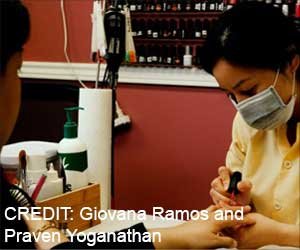What Health Issues Do Nail Salon & Beauty Service Workers Face?

A recent opinion written by Dr. Aurora Le, an associate professor at Texas A&M University School of Public Health, provides multi-layered insight into the complicated issues that these individuals in the beauty industry confront, as well as recommendations for interventions and legislative changes to address them. (
The beauty service microbusiness industry in the United States such as the small, independently-owned nail salons found across the country is huge, with more than $62 billion in annual sales. The majority of employees include immigrant Asians or Asian Americans.
They are reluctant to bring attention to the occupational hazards due to factors such as possible immigration-related trauma, lack of English proficiency, fear of losing their jobs, and unfamiliarity with American culture and business practices.
Advertisement
“This structure not only helps us understand how these multilayered issues affect each other but also helps us shape and prioritize strategies to address health issues and disparities through organizations, communities, and policies,” Le said.
For example, where the behavioral domain intersects with the interpersonal level of influence for Asian and Asian American beauty service workers, the researchers identified a lack of occupational health services and training, employment-related benefits and low wages, and other workplace health promotion benefits.
“This means that outreach and education at the individual level about occupational safety and health would require cultural competency and communication that includes materials not only in their language but also at their literacy level,” Le said. “The same would be true at the interpersonal level, which includes social interactions in the home and work environment, as well as larger social networks.”
“Still, it’s the case that most of these resources pertain to services such as how to enroll in and access health care, how to get legal help, and so on,” Le said. “Materials about occupational safety and health are extremely limited, especially for microbusinesses.”
Within the larger society level, which includes state-specific licensure and health department regulations, many beauty service microbusiness owners may lack a thorough understanding of the regulations and so might not be in compliance.
“It’s also the case that most of these businesses have fewer than 10 employees and thus are subject to fewer regulations, but also operate under razor-thin profit margins and struggle to survive,” Le said. “In addition, immigrant employees with little job security are much less likely to report unsafe practices.”
What are Possible Solutions for Health Challenges of Beauty Salon Employees?
How can these findings inform future occupational safety and health policies and practices?
“For one thing, it’s clear that little could be accomplished at the individual level for these beauty service workers,” Le said. “Instead, change will require collaboration by stakeholders who are invested in the community’s health and experts in areas such as business development who understand the context in which these workers operate. That means that training at the very minimum must be available in the workers’ preferred language and that these employers need to gain buy-in on the importance of workplace health and safety.”
At the community level, Le said community-based organizations for Asians and Asian Americans were at the forefront for these workers during the COVID-19 years, and now offer more resources on occupational safety and health issues. One example is the Vietnamese-American nonprofit Boat People SOS, which has added programming on chemical exposures for nail salon workers to its training.
At the larger society/policy level, the federal government has provided funding to some community-based organizations for safety outreach efforts to Asian and Asian American beauty service microbusinesses. Le said this has led some states to adopt safer practices and advocate for workplace standards for nail salons, including better wages and training and paid time off.
Finally, at the level of the occupational safety and health practitioner and researcher, Le said the best approach would be community-based participatory research, in which all parties have equal input and decision-making and build on existing assets to empower participants to have greater control over their lives.
Reference :
- The need for a multi-level approach to occupational safety and health among Asian and Asian American beauty service workers – (https://www.tandfonline.com/doi/full/10.1080/15459624.2023.2245447)
Source: Eurekalert
Source link
#Health #Issues #Nail #Salon #Beauty #Service #Workers #Face



